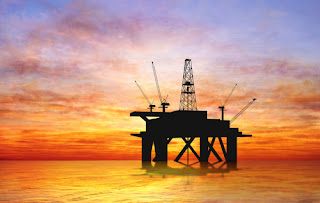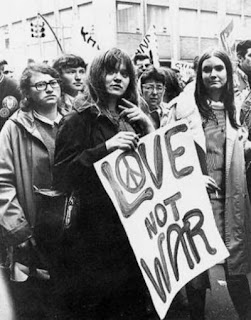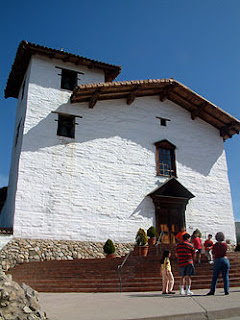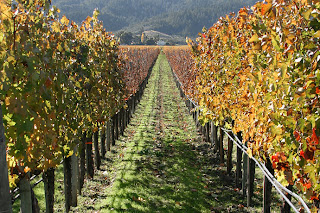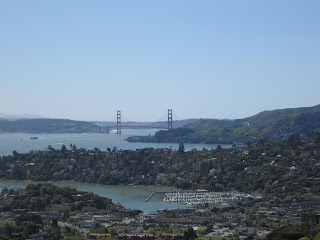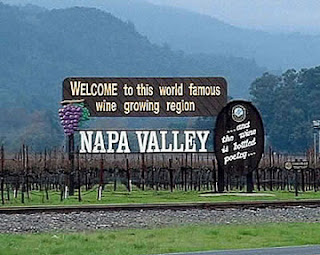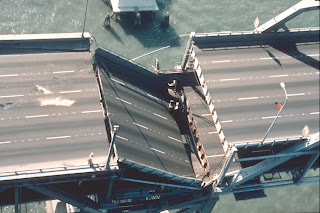The Coastal South and the Bay Area
The Coastal South and Bay Area are two very different regions in the United States for the following reasons. Although it is known for growing specific crops quite well, such as oranges in Florida, the Coastal South is a poor region for agriculture. The soil is infertile and the hot, humid weather is restrictive to what kind of plants can grow in the region. This is very different from the Bay Area's mediterranean climate and rich soils that allow for many different crops to strive. The Bay Area is known for it's wine and high quality food production. The Coastal South is known for rich oil reserves and petroleum production. Although there is drilling off California's shores and refineries in the Bay Area, it is nothing compared to the scale of the Gulf Coast. In terms of the tertiary and quaternary sectors of the Coastal South's economy, government and military services and tourist services are key to the economy. This is in contrast to the Bay Area, which has minimal government and military presence in the economy. The economy of the Bay Area is much more relient on technology and innovation and although San Francisco is a tourist city, it cannot compare to the gulf region and places like Disney World.
The Inland South and the Bay Area
The Inland South has been a huge contributor to culture in the United States and continues to be a very distinct cultural center. Country music has come out of the South and influenced many other musical genres. The South has a strong sense of military pride and memorializes war heroes such as Robert E. Lee. Southern traditions have influenced many aspects of American living to this day.
The opposite of culture is counter culture. Counter culture is a subculture that defies mainstream societies norms, values, behaviors, and expectations. The Hippie counter culture ideals were peace, love, freedom, music, sexual liberation and harmony. They were political activists and opposed the Vietnam war by protesting and burning draft cards. Hippie's believed in a deeper spiritual connection with ones self and the world. Psychedelic drugs, yoga, and meditation were used to expand ones consciousness.
There have been many different counter culture era's throughout history but the most prominent in the United States was the Hippie counter culture of the 1960's and 70's. During this era the Bay Area was a key region for counter culture. San Francisco, specifically Haight-Ashbury street, became a haven for hippies and they flocked to the city during this era. Berkeley was also a popular city for the counter culture movement. Many young, white, UC Berkeley students participated in the movement. From this era new cultural ideals were created that are still present today. The Bay Area continues to be a very liberal region especially in cities such as Berkeley. To this day there are still many signs of the influence of counter culture in the Bay Area.
The Great Lakes, Corn Belt, and Bay Area
The Great Lakes and Corn Belt region varies in many ways from the Bay Area. This region is considered the "heartland" of the United States because there is a perception associated with the Great Lakes and Corn Belt of "true American values" being present here. This belief is in contrast to the "foreign" influences on the East and West coast of the United States.
In terms of the Bay Area, foreign influence is very present in this region due to its location on the Pacific coast with easy access to sea travel. For example, San Francisco has the largest China town in the United States due to immigration from Asia across the Pacific ocean. Hispanic influence is also very evident throughout the Bay Area and California. For example, San Jose is the oldest city in California founded as a Spanish colony in 1777. The city still bears the Spanish influenced name and classic Spanish architecture is present throughout the city.
The Great Lakes and Corn Belt region has been historically known for its manufacturing industry. Cities such as Detroit, with its automotive industry, have been vital to the economy in this region. The Bay Area differs from the Great Lakes and Corn Belt because the economy is powered by the technology industry.
Silicon Valley is not only the economic hub of the Bay Area, but of California. It is considered the United States hub of high tech innovation and development. Silicon Valley is home of the startup tech business and many fortune 500 companies. New technologies and services are constantly being created here. Although there is an aspect of manufacturing that comes with the development of technology such as computers and smart phones, this high tech industry is powering the Bay Areas economy.
In terms of the Bay Area, foreign influence is very present in this region due to its location on the Pacific coast with easy access to sea travel. For example, San Francisco has the largest China town in the United States due to immigration from Asia across the Pacific ocean. Hispanic influence is also very evident throughout the Bay Area and California. For example, San Jose is the oldest city in California founded as a Spanish colony in 1777. The city still bears the Spanish influenced name and classic Spanish architecture is present throughout the city.
The Great Lakes and Corn Belt region has been historically known for its manufacturing industry. Cities such as Detroit, with its automotive industry, have been vital to the economy in this region. The Bay Area differs from the Great Lakes and Corn Belt because the economy is powered by the technology industry.
Silicon Valley is not only the economic hub of the Bay Area, but of California. It is considered the United States hub of high tech innovation and development. Silicon Valley is home of the startup tech business and many fortune 500 companies. New technologies and services are constantly being created here. Although there is an aspect of manufacturing that comes with the development of technology such as computers and smart phones, this high tech industry is powering the Bay Areas economy.
Megalopolis and the Bay Area
In 1961, the French geographer Jean Gottmann coined the term megalopolis to describe the densely populated urban corridor of the northeastern United States. The cities of San Francisco and San Jose in the Bay Area can be considered a megalopolis. These two urban areas combined are the 55th largest urban areas in the world, second in California, and first in Northern California. Similar to megalopolis, these are two relatively small, but very densely populated cities with huge economies. In fact, San Francisco is the second most densely populated city after New York. San Jose has the biggest economy in California and is the technological hub of the United Sates. San Jose and San Francisco have the second largest fortune 500 companies to the megalopolis of New York. These cities also held the number one rank in 2009 for households with $1 million assets, New York being second. If New York is the megalopolis of the East Coast, the Bay Area is the megalopolis of the West coast.
The Atlantic Periphery and the Bay Area
The Atlantic periphery is a region consisting of multiple states including Maine, New Hampshire, Vermont, and New York. Although the Bay Area is one region in the state of California it can be compared to the Atlantic Periphery. The Bay Area is similar to the Atlantic Periphery in that it is a region consisting of multiple cities and counties. The Bay Area can be broken down into the following sub-regions: East Bay, North Bay, Peninsula, San Francisco, San Jose and the Silicon Valley, and Santa Cruz and San Benito.
The East Bay is located on the eastern side of the San Francisco bay and is made up of Alameda and Contra Costa counties. The East Bay includes Oakland, Berkeley, Richmond, Emeryville and many others. My hometown of Pinole is also located in the East Bay. The East Bay is densely populated and very diverse. Pixar studios is based out of the city of Emeryville. Oakland is home to the Bay Area's largest sea port and home to the Oakland Raiders, Oakland A's, and Golden State warriors. Berkeley is famous for it's hippie culture and the main UC Berkeley campus is located here.
The North bay is located on the North side of the San Francisco bay and the North end of the Golden Gate bridge. It encompasses Marin county, Napa county, Sonoma county, and Solano county. Although this is a very rural region in the Bay Area, Marin county is the wealthiest county in the state. Napa county is wine country where vineyards run as far as the eye can see. There is also a lot of farmland in this region.
The Peninsula is located between San Francisco and the Silicon Valley but does not include either. Sn Mateo and Santa Clara county overlap in this region. Cities making up this region include Palo Alto, Half Moon Bay, and Burlingame. This area is mainly suburban neighborhoods and is very diverse.
San Francisco is at the northern most part of the peninsula and surrounded by water except to the south. It is a small city in terms of area, only 46.9 square miles, in which 805,000 people live. San Francisco is the most densely populated city in the US after New York. San Francisco attracts the most commuters on a daily basis, however population growth hasn't increased. This is due to lack of space and increasingly high property values. It is a very diverse city with many historical neighborhoods such as the Tenderloin and Castro. San Francisco is home of the World Champion Giants and the 49ers (for now).
San Jose and the Silicon Valley is the biggest urban area in California after Los Angeles. It is located in the southern Bay Area. This region is the technology capital of the United States and hence has received the nickname Silicon Valley. It is home to Apple, Facebook, Google, eBay and many more large companies. San Jose was California's first capital and the oldest city in the state. San Jose is densely populated, about 2 million residents, making it the tenth most populated city in the US and is ethnically diverse. San Jose is home to the San Jose Sharks and San Jose Earthquakes. Santa Clara is a near by city where Stanford is located and the new 49ers stadium is being built.
Santa Cruz and San Benito are considered parts of the Bay Area, but that is controversial. These cities are located on the coast south west of San Jose in the Santa Cruz mountains. Santa Cruz is a historically liberal city and home to UC Santa Cruz. Similar to Santa Monica, Santa Cruz has a many beaches and a beach boardwalk with roller coasters, rides, and a ferris wheel.
The Bay Area economy
The Bay Area has always been a key port city. San Francisco, Oakland, Alameda, Richmond and many other cities have ports located on the bay. These ports combined with railroad transportation make the Bay Area prime for importing and exporting of goods. For example, Oakland is a major railroad terminal and the fifth largest container shipping port in the United States.
California has an economy that can compare to other countries and the Bay Area is leading California's economy. In 2012, the Bay Area had a GDP (Gross domestic product) of $535 billion which ranks 19th in the world compared to national economies. In addition, the Bay Area had the highest GDP per capita in the United States at about $74,000. The Bay Area has the highest concentration of research laboratories, venture capital firms, and top ten ranked graduate and law schools including UC Berkeley and Stanford.
The economic hub for the Bay Area is the Silicon Valley located in San Jose. The Silicon Valley is home to Google, Facebook, Apple, Yahoo! and many other leaders in technology. Between San Jose, San Francisco, and Oakland, the Bay Area has the second most fortune 500 companies in the United States after New York. Silicon Valley generates most of the Bay Area's GDP.
The Bay Area is known for its agriculture, organic farming, and sustainable energy. It is also home to Napa valley, known famously as wine country. This production of high quality food and wine contribute greatly to the economy.
With all this being said, the Bay Area is known as one of the most expensive regions to live in the country.
California has an economy that can compare to other countries and the Bay Area is leading California's economy. In 2012, the Bay Area had a GDP (Gross domestic product) of $535 billion which ranks 19th in the world compared to national economies. In addition, the Bay Area had the highest GDP per capita in the United States at about $74,000. The Bay Area has the highest concentration of research laboratories, venture capital firms, and top ten ranked graduate and law schools including UC Berkeley and Stanford.
The economic hub for the Bay Area is the Silicon Valley located in San Jose. The Silicon Valley is home to Google, Facebook, Apple, Yahoo! and many other leaders in technology. Between San Jose, San Francisco, and Oakland, the Bay Area has the second most fortune 500 companies in the United States after New York. Silicon Valley generates most of the Bay Area's GDP.
The Bay Area is known for its agriculture, organic farming, and sustainable energy. It is also home to Napa valley, known famously as wine country. This production of high quality food and wine contribute greatly to the economy.
With all this being said, the Bay Area is known as one of the most expensive regions to live in the country.
Historical Settlement of the Bay Area
Francisco, like most of California, grew tremendously after the discovery of gold in 1848. It's location on the peninsula of the San Francisco bay with access to the Pacific Ocean made it a very important port city during the Gold Rush. From San Francisco, gold could easily be transported out of the Bay Area, while goods and people could be easily transported into the region. San Francisco's location made it vital to intercontinental trade by boat, which was the most effective means of transportation at the time. In addition, transportation routes by land were created to connect San Francisco with the Central Valley, the Sierras, coastal valleys, the redwood coast, and Monterey coast. These connections made San Francisco the primary city supporting settlement in California. By 1850, San Francisco had grown to be the largest city on the West coast, and remained the largest until 1920. When the transcontinental railroad was completed in 1869 San Francisco became the West's leading railroad center, further connecting it with the rest of the country and increasing migration to the Bay Area.
San Francisco and the Bay Area has always been a diverse ethnic region due to its status as the leading port of entry on the West Coast in the 19th century. Immigrants from all over the world including China, Germany, Russia, Britain, Latin America and Italy migrated to San Francisco mainly by ship into the Bay Area's ports. Many of these migrants were fisherman and sailors and different ethnic groups dominated different areas of the workforce. For example, the Italians dominated the garbage disposal services in San Francisco and continue to do so today. The Portugese dominated jobs in Bay Area ports including San Francisco, Oakland, and Alameda ports. A substantial amount of Chinese immigrants came to San Francisco because of it's access to the Pacific ocean and today San Francisco still has the largest Chinatown in North America.
Environmental Setting of the Bay Area
The Bay Area is known for its complex and diverse terrain and landforms. The region is made up of mountains, hills, valleys, low lands, marshes, and large bodies of water. The highest point in the Bay Area is Mt. Hamilton at 4,360 feet. The largest body of water is the San Francisco bay measuring 3 to 12 miles wide east-to-west and somewhere between 48 miles and 60 miles north-to-south. It is the largest pacific estuary in the Americas and drains around forty percent of water from California including from the San Joaquin and Sacramento rivers and the Sierra Nevadas. There are five islands in the San Francisco bay, Yerba Buena island, Angel island, Alameda island, Alcatraz island, and Mare island. Angel island is known as Ellis island of the west because it served as an entry point for immigrants from Asia. Alcatraz island is home to the famous federal penitentiary that is now a popular tourist attraction. The entrance to the bay from the Pacific Ocean is called the Golden Gate and is spanned by the Golden Gate bridge.

The diverse terrain of the Bay Area has been created from millions of years of plate tectonics. The biggest fault running underneath the Bay Area is the San Andreas fault, however there are hundreds of sister faults also running through the region. Because of these fault lines the Bay Area, like most of California, is very susceptible to earthquakes. For example, the 1906 San Francisco earthquake that registered a 7.8 magnitude, killed over 3,000 people, and destroyed over 80% of San Francisco. More recently, the 1989 Loma Prieta earthquake, also known as the World Series earthquake because it occurred during warmups before the Oakland A's and San Francisco Giants squared off in game three. That quake registered a 6.9 magnitude and damaged infrastructure throughout the Bay Area including collapsing the upper deck of the Bay Bridge.
The Bay Area is known for its microclimates due to the differences in terrain and proximity to water. Areas near the water including the coast and the bay, experience small temperature variations, cool foggy summers, and mild rainy winters. Inland regions experience hotter days and colder nights. The South Bay averages 15 inches of rain a year, while the North Bay averages over 30 inches. Snow falls on the higher elevations including Mt. Hamilton, Mt. Tamalpais, and Mt. Diablo. They say in the Bay Area if you want a change in temperature, just go over the hill!
Introduction to the Bay Area
The San Francisco Bay Area, or simply the Bay Area, is a region in Northern California, United States. Located about 400 miles North of Los Angeles, the Bay Area is a collection of cities and counties surrounding the San Francisco Bay including San Francisco, Oakland, and San Jose. The combined area of San Francisco and San Jose is the second largest in California to Los Angeles. 7.15 million people call this 6,984 square mile region home. The Bay Area is known for its scenic beauty, liberal culture, entrepreneurship and diversity.
Subscribe to:
Comments (Atom)

